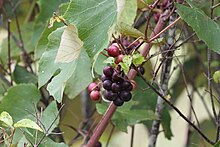
Back كرمة شفوية Arabic كرمه شفويه ARZ Labrusk üzümü Azerbaijani Llambrusca Catalan Vitis labrusca CEB Amerikansk vin Danish Vitis labrusca German Vitis labrusca Esperanto Vitis labrusca Spanish انگور روباهی Persian
| Fox grape | |
|---|---|

| |
| Scientific classification | |
| Kingdom: | Plantae |
| Clade: | Tracheophytes |
| Clade: | Angiosperms |
| Clade: | Eudicots |
| Clade: | Rosids |
| Order: | Vitales |
| Family: | Vitaceae |
| Genus: | Vitis |
| Species: | V. labrusca
|
| Binomial name | |
| Vitis labrusca | |
Vitis labrusca, the fox grape, is a species of grapevines belonging to the Vitis genus in the flowering plant family Vitaceae. The vines are native to eastern North America and are the source of many grape cultivars, including Catawba, Concord, Delaware, Isabella, Niagara, and many hybrid grape varieties such as Agawam, Alexander and Onaka. Among the characteristics of this vine species in contrast to the European wine grape Vitis vinifera are its "slip-skin" that allows the skin of the grape berries to easily slip off when squeezed, instead of crushing the pulp, and the presence of tendrils on every node of the cane. Another contrast with European vinifera is the characteristic "foxy" musk of V. labrusca, best known to most people through the Concord grape.[1] This musk is not related to the mammalian fox, but rather to the strong, earthy aromas characteristic of the grapes that were known by early European-American settlers in the New World. The term "foxy" became a sort of catchall for the wine tasting descriptors used for these American wines that were distinct from the familiar flavors of the European viniferous wines.[2]
- ^ Jancis Robinson (ed.) The Oxford Companion to Wine (Oxford University Press, third edition 2006, ISBN 0-19-860990-6), pp 19-20
- ^ B. Ramey The Great Wine Grapes Concord, Catawaba and Delaware entries (no page numbers in book) University of California-Davis, 1977 ASIN B0006CZP4S
